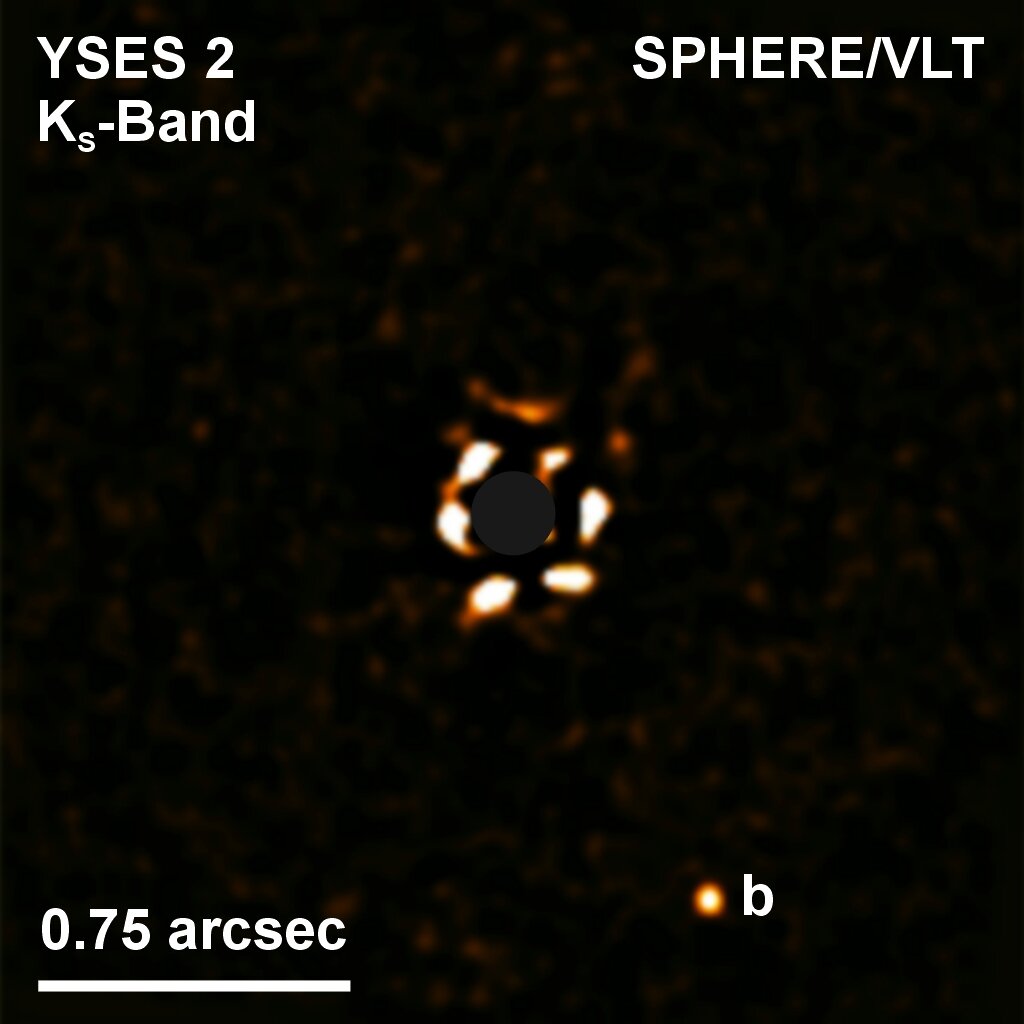
A direct image of the exoplanet YSES 2b (bottom right) and its star (center). The star is blocked by a so-called coronagraph. Credit: ESO / SPHERE / VLT / Bohn et al.
A team of astronomers led by Dutch scientists has photographed a giant planet directly at a great distance around a sunny star. Why this planet is so massive and how it should have been there is a mystery. The researchers will publish their findings in the journal Astronomy & Astrophysics.
The planet in question is YSES 2b, located 360 light-years from Earth in the direction of the southern constellation Musca (Latin for The Fly). The gaseous planet is six times heavier than Jupiter, the largest planet in our solar system. The newly discovered planet orbits 110 times farther from its star than the earth from the sun (or 20 times the distance between the sun and Jupiter). The accompanying star is only 14 million years old and looks like our sun in its childhood.
The great distance from the planet to the star presents a mystery to astronomers, as it does not appear to be one of the two best-known models for the formation of large gas planets. If the planet at the present location had grown far away from the star by means of nuclear wax, it would be too heavy because there is not enough material to make a large planet at this great distance from the star. If the planet was created by so-called gravitational instability in the planetary disk, it does not appear to be heavy enough. A third possibility is that the planet was formed by nuclear growth near the star and then migrated outward. However, such a migration requires the gravitational influence of a second planet, which the researchers have not yet found.
The astronomers will continue to study the environment of this unusual planet and its star in the near future, hoping to learn more about the system, and they will continue to search for other gaseous planets around young, sunny stars. Current telescopes are not yet large enough to depict direct imaging of earth-like planets around solar-like stars.
Lead researcher Alexander Bohn (Leiden University): “By exploring more Jupiter-like exoplanets in the near future, we will learn more about the formation processes of gas giants around solar stars.”
The planet YSES 2b was discovered with the Young Suns Exoplanet Survey (YSES). This survey has already yielded the first direct image of a multi-planet system around a solar star in 2020. The researchers made their observations in 2018 and 2020 using the Very Large Telescope of the European Southern Observatory (ESO) in Chile. They used the telescope’s SPHERE tool for this. This instrument was developed with the Netherlands and can capture direct and indirect light from exoplanets.
Astronomers finally measure polarized light from the exoplanet
Discovery of a directly imaged planet to the young solar analogue YSES 2. By: Alexander J. Bohn et al. Accept for publication in Astronomy & Astrophysics, www.aanda.org/10.1051/0004-6361/202140508
Preview (PDF): www.astronomie.nl/upload/files… /Bohn-et-al-2021.pdf
Provided by the Dutch Research School of Astronomy
Quotation: Giant planet at great distance from astronomers from the sun like mysteries (2021, April 19), on April 19, 2021 from https://phys.org/news/2021-04-giant-planet-large-distance-sun- like detected. html
This document is subject to copyright. Apart from any fair trade for the purpose of private study or research, no portion may be reproduced without the written permission. The content is provided for informational purposes only.
